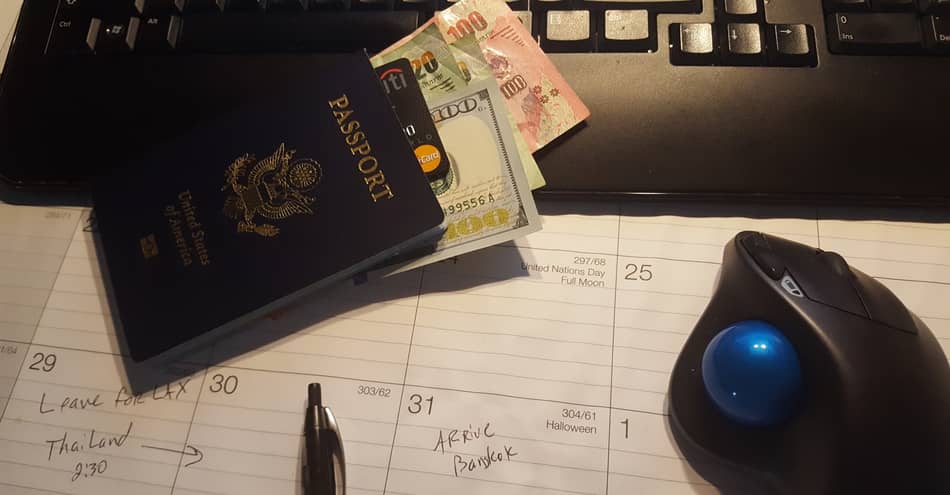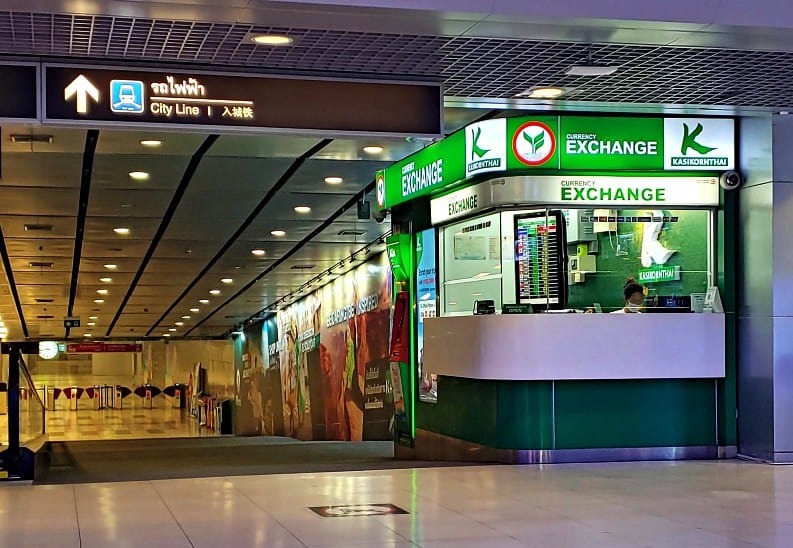
When I sat down and planned my first trip to Thailand, I didn’t think too much about the money side of thing’s. Getting everything booked and scheduled was my main focus. It just didn’t come up. That is until my credit card company blocked one of my bookings.
Should you bring cash or cards to Thailand? The answer is yes to both. Should you “use” both for your trip in Thailand? That part is entirely up to you. First, let’s get you up to speed on both cash and cards so you can make an informed decision.
Credit Cards: What you should know.
- Let’s start from the beginning. As I mentioned in the introduction to this article, my credit card company had blocked one of my bookings in Thailand. The reason was simple. I didn’t call them and inform them that I was going to use the card in Thailand. The card company thought my card was being used fraudulently. (I think you would agree that that was a good thing). So, make sure you call your credit card company and tell them you are planning a trip to Thailand. They will ask you all the pertinent questions and let you know about any restrictions and so forth.
- This one I found out the hard way. When I came back from my trip I got my credit card statement. It had foreign transaction fees on all my purchases in Thailand. My fees were only 3% so not really a big deal to me. But if you don’t want to pay those fees, ask your credit card company if they have a card without foreign transaction fees. They might be willing to move you to a new card within the same account and with the same credit limit. The card number will change of course.
- Use the above steps on all the cards you plan on bringing on your trip. The reason I say “all the cards” is because I bring all my cards with me. Here’s why. Emergency! You just can’t predict what might happen. I always make sure I have as much open credit as possible on my cards when I go on my trip. You just never know if you will need it.
- If you don’t have a credit card and would like one, you can go to your bank and apply for a secured credit card. You give the bank three to five hundred dollars deposit in return for a card of equal value. If you make all your payment on time, they will give you your money back and your card will become a normal unsecured card. If all you have is a five hundred dollar limit card? That is still fine. That will go quite a long way in Thailand. More on that in the cash section.
- The most widely accepted credit cards in Thailand are MasterCard and Visa followed by American Express. Most mid to large restaurants, hotels and department stores, especially in the more touristy areas except these credit cards. I wouldn’t bother bringing Discover or Diners Club cards to Thailand, as they are very rarely accepted there. In conclusion, use credit cards if you have no fees or don’t mind the fees.
ATM/Debit cards: What to expect.
- Although I stay away from using ATM’s even at home, this is a way to get cash while you are in Thailand. ATM/debit cards are accepted all over Thailand for getting cash out of 24 hour ATM machines. The cash machines in Thailand used to only except four digit PIN numbers. But don’t worry, the banks in Thailand are now accepting 6 digit PIN numbers.
- Unfortunately, the fees are quite high for withdrawing cash from ATMs in Thailand. Thai banks charge a 150 to 200 baht (around 4.60 to 6.15 US) fee per withdrawal from ATMs. You should also ask your own bank to find out what fees they will charge you for using ATMs in Thailand. If you are on a strict budget, this might be a last resort for getting spending money for your stay in Thailand.
- Most Thai ATMs will have a daily withdrawal limit of 20,000 THB (approximately $615.00 US). Make sure you choose to be charged in local currency when you use ATMs in Thailand. This will give you the best possible exchange rate. Do not choose your home currency.
- And don’t worry, if you still have an older card with a magnetic strip on back. Thai ATMs will also work with both the chip and magnetic strip type cards. And Thai ATMs will work with Maestro, Cirrus and the MasterCard and Visa (Plus) cards.
- One other way to use your debit card in Thailand, is to walk into a bank. With this method you can avoid the ATM fees. The problem here is the exchange rate won’t be as good and you will still be charged foreign transaction fees by your own bank. Either way ATMs will cost you more than using cash or credit cards.
Cash: The ins and outs
- Actually, I don’t think there really are any outs. Cash is my number one choice for “spending” money in Thailand. It’s simple and it helps you to better understand Thai currency. Here’s how it works.
- Baht is the official currency of Thailand and It is subdivided into 100 satang. Unlike the US paper 1 dollar bill, the equivalent 1 Thai BAHT is a coin.
- Coins work like this. 25 satang and 50 satang. Which is like 25 cents and 50 cents US. 1 baht, 2 baht, 5 baht and 10 baht are equivalent to $1, $2, $5 and $10 US bills. Like a lot of you, I never use my spare change at home. It goes into a big jar and when it is full, it goes into my savings account.
In Thailand, 1 baht is a coin, so it takes a little getting used to. Not spending that 10 baht coin is like putting a 10 dollar bill in your change jar at home. So just remember, the 10 baht coin is not 10 cents, it is like 10 bucks.
- Banknotes work like this. 20 baht, 50 baht, 100 baht, 500 baht and 1000 baht, equivalent to $20, $50, $100, $500 and $1000 US banknotes. Walking around with all this cash is a little strange at first but you will get used to it. That brings us to exchanging your US dollars to Thai baht.
- A couple days before my flight, I go into my bank. I withdraw the amount of money I think I will need in brand new one hundred dollar bills. No wrinkles, tares, writing, nothing. Ask for as close to band new as possible. The reason for this is as follows. Thai banks will not except US bills that are blemished in any way. The exchanges might, but the banks won’t. Period!
- Normally I wouldn’t use a bank but I was in an area that didn’t have any money exchanges and I needed some more cash. I went into three different banks to exchange a fifty dollar bill and they all refused my bill. It literally only had a slight wrinkle on one corner. Make sure you get new bills and keep them in your wallet until you exchange them. Exchanging your hard earned money in Thailand is pretty simple. Here are some tips.
- You don’t need any other size bills. Just one hundred dollar bills. The reason for this is that they give the best exchange rates. Twenty and fifty dollar bills will get you slightly smaller exchange rates so I don’t even bother with them.
- There are lots of exchanges to choose from and they all have better rates than banks and ATMs. But I use an exchange called Super Rich Thailand (the green one, not the yellow one) because they seem to always have the best rates. The rates between exchanges are not so extreme as to say not to use them. In fact they are really only a few points from each other. Just look for the best rate and you will be okay.
- Update: Super Rich Thailand is no longer open so I use the one in the pic below, “Kasikornthai”.

- The majority of the exchanges are in kiosks (or booths) and banks are also using kiosks. They look very similar so make sure you read the signs. If the word “bank” is in the sign, then it is a bank and there rate will be lower.
- The next thing is determining how much money you should exchange. This is the fun part. The exchange rate as I am writing this is 32.57. That means if you exchanged a one hundred dollar bill, you would get 3,257.01 baht. I know what you are thinking. Yes, that seems like a lot of money. That is true and it will go a long way in Thailand, depending on what you are spending it on. Let’s break it down to give you a general idea.
- Let’s say you paid for all your bookings (lodging, car rental, etc..) at home with credit cards. Now you just need to determine what you are going to spend per person a day.
Let’s say you go to a big hotel restaurant and order a beer, sôm-dtam (papaya salad) and pàt-gà-prao (holy basil chicken). This would cost around 350 baht or $10.75. Not bad for a more expensive place to eat. Time for some math. Eating like that two times a day would run you around 700 baht ($21.50) a day for 18 days is $387.00.
So just in eating out you would need to exchange four hundred dollars. You will probably spend less than that depending on you lifestyle, but this gives you a starting point on determining how much to exchange. And remember, if you have leftover baht, you can always exchange it back to US dollars.
- Now you might be asking. When should I exchange my money to Thai baht? Most people traveling to Thailand fly into Bangkok’s Suvarnabhumi International Airport. After going through security and baggage, head down to the basement floor. There you will look for the underground rail link down the ramp. On the left side you will find lots of exchange kiosks. Look for the best rate, take out your money and passport and hand it to the teller. They will give back your passport, Thai baht and a receipt.
That’s it! And with no cost to you. For me this is the easiest way to start your Thailand adventure. After the airport, if you exchanged enough money, all you will have to think about for the rest of your time in Thailand, is where to go and what to do.
Happy Thailand Travels!

